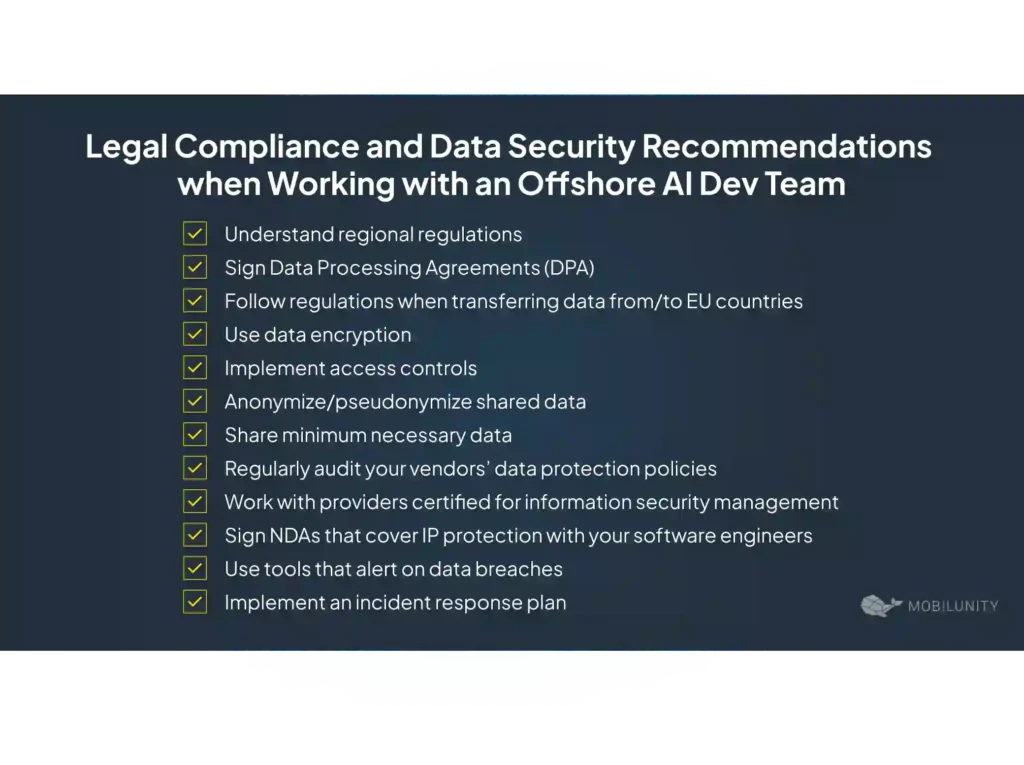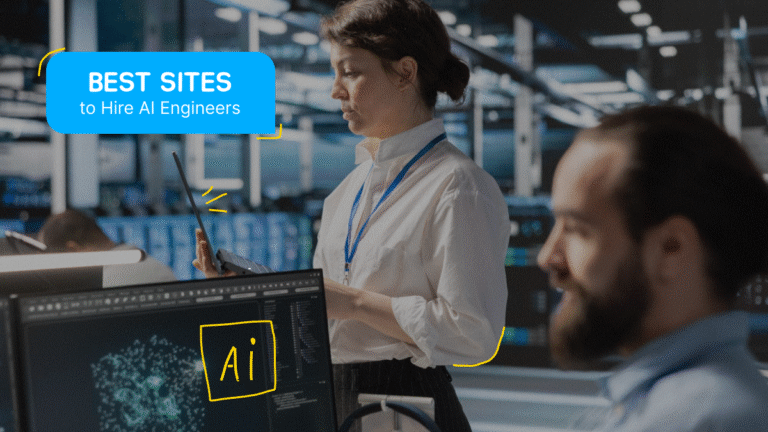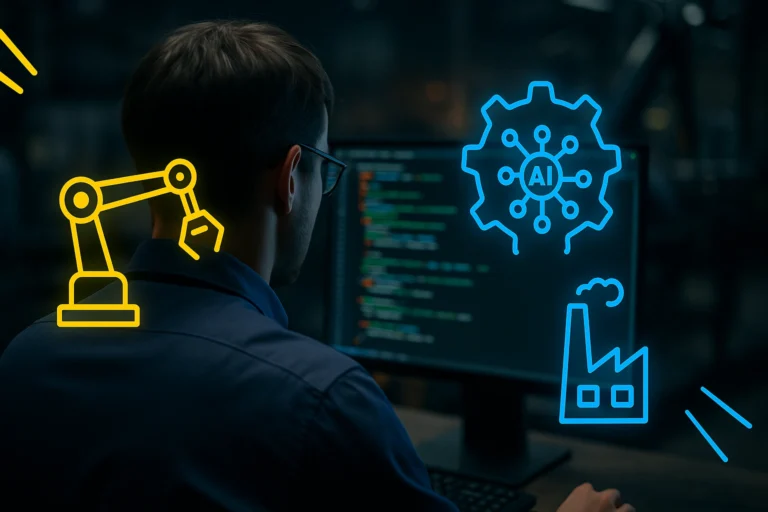Why And How To Build An Offshore Team For AI Development
- Why Consider An Offshore AI Team?
- Key Steps To Building A Remote Team For AI Development
- Best Practices For Managing An Offshore Team Of AI Developers
- Overcoming Challenges In Offshore AI Development
- Choosing The Right Location For Your Offshore Development Team
- Measuring The Success Of Your Offshore AI Team
- Conclusion
- You may also like it:
Is offshoring an AI tech team a worthy strategic move and a competitive advantage your business can gain? Or does building an in-house tech team sound safer?
Let’s explore why assembling a remote AI team can be a game-changer and learn its key benefits and challenges.
Why Consider An Offshore AI Team?
Hiring AI software developers in offshore destinations has several benefits for your business:
- Cost savings. In countries with moderate living standards, developers’ salaries are significantly lower than in the US or EU. At the same time, the technical background of seasoned AI experts based in Ukraine, China, Vietnam, etc., is strong. So, you can hire ML developers cost-effectively without compromising the code quality.
Here’s what Shunsuke Masuda, the Co-Founder and Managing director at pafin (FinTech), Japan, says about working with an dedicated dev team company:
“We are very satisfied with the quality of services provided by the Mobilunity-BPO team and flexibility in adjusting to our instructions. This cooperation allowed us to release the product faster and optimize the budget”.
- Faster recruitment. Access to the global AI talent pool allows you to hire rare-skilled and domain-specific developers within weeks, not months. No matter the mix of skills, stacks, and roles required for your project, it’s possible to build an offshore AI team within around 6 weeks, while in Switzerland or the UK, it can take up to 3-6 months.
Jörg Schneider-Simon, the Chief Technology Office & Co-Founder of Bowbridge, a German SAP cybersecurity software provider, highlights the speed of hiring tech experts with an development talent vendor:
“Mobilunity was able — within days — to provide a full-time resource to pick up the work where it was”.
- Faster time to market. Engaging software engineers based in different time zones can boost productivity, shorten project timelines, and accelerate development cycles. You’ll release AI-driven tools faster with “extended” working hours and optimize costs on their creation.
Christian Klauenbösch, CEO at Network of Arts, Switzerland, proves this when saying:
“Since we work together with Mobilunity, we were able to accelerate our development speed.”
- Team scalability and flexibility. Regardless of your initial team structure, you can promptly scale up with your AI project. Add new AI developers on the go and without an extensive employment process. Additionally, you can pause your project or scale your team down for a while.
Emmanuel Belo, the Business Unit Manager at Camptocamp, a Swiss company developing and integrating open-source software, points out the ability of the dedicated development team company to hire engineers swiftly:
“Mobilunity was of great help at the time we needed to scale the team quickly.”
Key Steps To Building A Remote Team For AI Development
Assembling a high-achieving team depends on how thoroughly you approach each of these steps:
Define Your AI Development Goals
Combine business, technical, and user requirements into actionable, clear goals.
First, state a broad but measurable objective based on the problem you’re solving with Artificial Intelligence — for instance, growing customer retention or increasing revenues.
Then, set specific and trackable targets, like “resolving 70% of customer queries with a chatbot,” and develop metrics to assess progress. These can be, for instance, CSAT (Customer Satisfaction Score) or NPS (Net Promoter Score).
Think about what data you’ll need to train, validate, and test your model, and consider if this data will be accessible and sufficient for reaching your strategic goals. Define the volume and frequency of data analysis and processing.
Break the project into phases, define success metrics, assess your ML model performance risks and fallbacks, and align your goals with your budget.
Identify Required Skills and Roles
Once you determine the goals of your AI software and its stages, identify the specialized skills and expertise required for your AI engineering team.
Below is the breakdown of typical roles on an AI development project.
|
Roles |
Responsibilities |
|
Project Lead |
Monitoring the system’s design, selecting algorithms and architecture |
|
Product Owner/ Business Analyst |
Ensuring that solutions meet business objectives and stakeholders’ needs |
|
Project Manager |
Managing deadlines, software engineers workload, and effective collaboration |
|
DevOps Engineer |
Making the infrastructure for the model implementation reliable, scalable, and connected with other company’s systems |
|
Data Engineer |
Preparing data for the model, managing data infrastructure |
|
Data Science Engineer |
Developing and refining models |
|
ML Engineer |
Implementing, testing, and deploying AI/ML models to production systems |
|
UI/UX Designer |
Creating appealing user interfaces, analyzing user experiences |
|
Software Engineers |
Building software architecture, integrating Machine Learning models into applications, developing backend/frontend/API |
Think how many offshore tech experts can complete the project on time. Also, consider the location of your dedicated software development team — we’ll advise on it in the following sections.
Select an Dedicated Talent Vendor
It’s time to conduct thorough research on dedicated dev team companies in a selected destination.
Check the portfolios of potential offshore partners, their experience in finding AI and machine learning developers for your industry, and their geography. Explore how fast they close vacancies, how long they work with a client on average, and how flexible they are to your specific needs.
Here are several points that Mobilunity’s Founder Cyril Samovskiy recommends to consider:
- Transparent pricing. Does your future partner charge per head, hour, or month? Is the vendor ready to share a developer’s gross rate and the service fee? Ask them to break down the price of maintaining an offshore AI tech team.
- Client references. Ask the provider to name 3-4 clients ready to share their experiences in hiring and managing an offshore team. Their feedback in a phone conversation can give you more understanding than client testimonials and case studies.
- Contract summary. Ask for a one-page contract outline for hiring an offshore dev team. It’ll help you learn and compare both parties’ obligations with other providers. It can include fee structure, Intellectual Property rights, liabilities, etc.
- Vendor size. Though it’s not apparent, your provider’s size matters; ideally, it should be similar to yours. A larger vendor will hardly be willing to collaborate, adapting to your project requirements. A smaller one may lack the recruitment capacity to ensure smooth and stable cooperation.
Set Up Communication and Management Frameworks
Teamwork software is crucial for keeping your offsite developers engaged and productive.
Below are the instruments that will help you keep your team on track.
|
Classification |
Tools |
Used for |
|
Project management | AsanaJiraTrello | Assigning responsibilitiesMonitoring progress Tracking tasksSetting deadlines |
NotionConfluence | Maintaining knowledge basesSharing documentation | |
|
Real-time communication | SlackMicrosoft Teams | Sending instant informal messagesGetting notifications and task updates |
|
Video conferencing | Google MeetZoomMicrosoft Teams |
Arranging regular video meetings, sprint reviews, or decision-making sessions |
LoomCloudApp |
Recording video updates for asynchronous teams | |
|
Code collaboration | GitHubGitLab | Controlling code versionsReviewing pull requests and discussing |
|
CodeStream |
Commenting and discussing within the development environment | |
|
Issue tracking | BugSnagSentry | Reporting bugs and issues in real-timeAssigning issue resolution to relevant programmers |
Opt for the mix of Agile, CRISP-DM, and MLOps methodologies to handle evolving AI development projects.
Use Agile to cover continuous iterations, feedback loops, and adjustments, ensuring the flexibility and early validation of ML models.
The structured CRISP-DM approach lets your project manager focus on business understanding, data preparation, and model evaluation.
The MLOps principles like automated testing, version control, and continuous deployment facilitate the transition from development to production.
Best Practices For Managing An Offshore Team Of AI Developers
Make your team collaborative and high-performing with these proven approaches.
Clear Communication Channels
Effective communication is vital for offsite teams building an AI-driven solution from different locations and time zones.
Instant messaging, code collaboration, video conferencing, and project management software like Slack, Zoom, Jira, GitHub, etc., become invaluable.
They allow programmers to stay aligned and updated on the development process while PMs manage tasks, track progress, and resolve issues swiftly.
Here are a few basic principles of using collaboration software in a virtual team for AI product development:
- Create channels by project or function and assign responsible developers
- Define channels’ purposes and encourage group members to post relevant updates, questions, and documents
- Use threads to avoid communication overload
- Make general announcements in high-level channels
- Integrate tools to automate task updates.
QA and Performance Management
Maintaining the high quality of the deliverables of an AI team is crucial for the project’s success.
You’ll need to set up systematic processes and use specific tools to ensure your developers follow the industry standards and stay effective.
These 5 methods will let you keep the performance of your offshore team for AI software development high:
- Regular peer code reviews. Engineers will assess if their teammates follow the coding standards, find errors, and share knowledge.
- Automated testing. Monitor the functionality of your AI algorithms and catch bugs early with unit, regression, and integration tests.
- CI/CD. Set up the CI/CD pipelines to automatically test and deploy code before integration.
- Monitoring key metrics. Check your AI model’s infrastructure and real-time performance with Grafana, Prometheus, TensorBoard, and other tools.
- Regular check-ins. Promote transparency and identify areas for improvement by discussing your project’s progress and problems weekly.
Legal Compliance and Data Security
Working with an offshore team for AI product development requires adherence to these recommendations to ensure legal compliance and protection of sensitive data.

Overcoming Challenges In Offshore AI Development
Let’s explore the key constraints of maintaining a remote AI team and effective ways to overcome these limitations.
Communication and Language Barriers
Try these approaches and tools to address the language barrier in your team:
- Use simple language. Avoid slang, idioms, and complex phrases. Opt for precise, easy-to-understand words and instructions.
- Confirm understanding. Ask non-native English speakers to summarize key ideas after meetings and discussions.
- Encourage video conferencing. Facial expressions and tone of voice will foster communication and simplify ideas perception.
- Provide English language training. Arrange courses or English-speaking clubs to improve the conversational skills of tech experts.
Time Zone Differences
Here’s how you can minimize time zone challenges once you build an offshore team.

Retention and Talent Management
These several approaches will help you maintain your team’s high motivation and engagement required to complete the project:
- Offer competitive compensations
- Add performance-based bonuses
- Introduce flexible work schedules
- Incorporate professional development
- Define career paths
- Arrange regular feedback sessions
- Assign talented data scientists and Artificial Intelligence engineers to challenging tasks
- Recognize and appreciate cultural differences.
Choosing The Right Location For Your Offshore Development Team
Picking your team’s location is a strategic decision that embraces many aspects.
For instance, access to global talent pools will be limited by the local AI talent base. You’ll need to consider the salaries, qualifications, and culture of developers located in your country of interest.
Comparing Countries Based on Cost, Quality, and Cultural Compatibility
We’ve compared several offshore and nearshore destinations across the cost and quality of AI product development and ease of communication with local developers — from the perspective of EU and US businesses.
The average salaries of full-time AI engineers below come from Glassdoor. The Government AI Readiness Index 2023 ranks 193 countries with respect to various aspects of their willingness and readiness to develop and apply AI-powered solutions. This ranking gives an idea of the local engineers’ work quality.
As for cross-cultural alignment, we’ve used the gradation based on the following information.
Asians tend to be more indirect and sensitive non-verbal communicators who prioritize work, tolerate minor delays, and usually make top-down decisions.
Europeans and Americans prefer openness and well-defined processes, value their work-life balance, adhere to deadlines, and involve teammates in decision-making.
Latin Americans have formal and an indirect communication style and demonstrate a relationship-oriented approach to work. They have a flexible attitude toward deadlines, hierarchical decision-making, and a strong focus on family.
Note: All salaries and prices mentioned within the article are approximate NET numbers based on the research done by our in-house Recruitment Team. Please use these numbers as a guide for comparison purposes only and feel free to use the contact form to inquire on the specific cost of the talent according to your vacancy requirements and chosen model of engagement.
|
Country |
Annual Salary |
Government AI Readiness Index 2023 |
Cultural Alignment |
|
Philippines |
$6,876 |
65 |
Low |
|
Vietnam |
$7,596 |
59 |
Low |
|
Brazil |
$9,288 |
32 |
Moderate |
|
Mexico |
$12,624 |
68 |
Moderate |
|
Ukraine |
$32,976 |
60 |
High |
|
Romania |
$36,000 |
64 |
High |
|
Germany |
$59,626 |
8 |
High |
|
USA |
$105,954 |
1 |
High |
As the table shows, Eastern European and LATAM countries are the most favorable locations for remote AI developers in terms of cost, quality, and cultural fit.
Criteria for Selecting the Optimal Location for Your Offshore AI Team
These factors will help you align the location of your tech squad with your business objectives, operational requirements, and budget.
- Availability of AI engineers with the required skills
- Labor and operational costs
- Time zone difference
- Developers’ English proficiency
- Communication styles and work ethics
- IT Infrastructure
- Strong IP laws
- Compatible work culture
- Global connectivity.
Measuring The Success Of Your Offshore AI Team
You’ll need to monitor your team’s performance to ensure it stays productive and brings business value. Also, you should track if further investing in offshore teams aligns with what shareholders and C-level executives need.
The following metrics and approaches will help you assess your engineering team.
Key Performance Indicators (KPIs)
You can explore your team’s AI expertise and efficiency by analyzing these metrics:
- Meeting project milestones. Consistent and timely deliveries show that your team successfully manages time zone differences and remote working format.
- Code defect rate. The higher the adherence to coding standards and the lower the number of bugs and errors in your team’s code, the more productive your developers are.
- Response times and engagement. Quick responses in communication platforms, participation in meetings, and engagement in process optimization or product improvement signify your team’s involvement and effectiveness.
Return on Investment (ROI)
Assess your team’s cost efficiency and evaluate if you meet your business needs and goals by comparing the investments with the value generated by your offshore developers.
Here are several parameters to consider:
|
Parameters |
Description |
|
Cost savings compared to maintaining an on-site team: | |
|
Labor |
Compare the rates of your offsite developers with equivalent in-house resources required for performing similar tasks (salaries, office space, overheads, benefits). |
|
Infrastructure |
Offset the additional expenses on VPNs, collaboration tools, network security, etc., with the savings in labor. |
|
Productivity: | |
|
Rate of tasks delivered on time |
Calculate how many tasks your distributed team completes within the milestones compared to the total number of assignments. |
|
Productive vs. non-productive work time |
Compare the hours spent on development, model training, etc. (productive time) with resolving miscommunication, tracking tasks, covering time zone gaps, etc. (non-productive time). |
|
Quality of deliverables: | |
|
Defect rate and rework |
Check the number of errors in a code or a model and evaluate the time required for fixes and rework. |
|
Client and stakeholders’ satisfaction |
High satisfaction rates show that your remote developers work effectively. |
|
Time-to-market: | |
|
Speed of delivery |
Accelerated project timelines bring business value and give your company a competitive edge. |
|
Business impact |
Measure how your team contributes to the achieving of business goals like growing revenue or increasing product features. |
|
Total cost of ownership (TCO): | |
|
Ongoing maintenance cost |
Compare if your remote team spends less/more on maintenance and updates than its onshore alternatives. |
|
Hidden costs |
Check if implicit costs, like time spent on managing communication barriers or aligning cultural differences, affect your project’s cost-effectiveness. |
Continuous Improvement
Continuous improvement fosters a culture of learning, adaptability, and innovation, which are critical for optimizing workflows, enhancing tech facilities, and refining AI models and systems.
These principles will help you incorporate the ongoing-improvement attitude within your team:
- Encourage exploring the latest AI trends and visiting workshops
- Reflect on the previous cycle’s successes and challenges
- Conduct regular retrospectives
- Monitor performance metrics
- Promote A/B testing and feedback loops
- Organize hackathons and coding challenges
- Automate repetitive tasks
- Upgrade technologies
- Arrange cross-training
- Discuss ideas for improvement during 1:1 meetings
- Offer access to courses and conferences
- Run peer code reviews.
Conclusion
To successfully implement and maintain an offshore AI team, you need to set your AI development goals, define required skills and roles, select a vendor, and set up communication channels with your developers.
The right location, effective management and assessment, and proven approaches to overcoming challenges will help you leverage offshore teams for development and innovation.














Mobilunity insight
“Certainly, for most companies, the primary advantage is the SPEED at which they can scale the team up (or down), with QUALITY staying unconditionally higher than the local market can offer at this speed. The COST factor comes right after,” says Cyril.